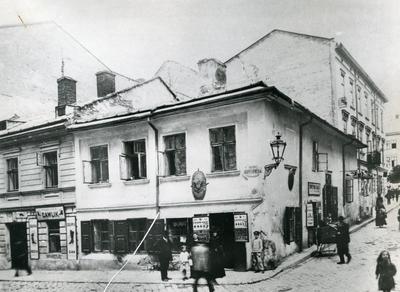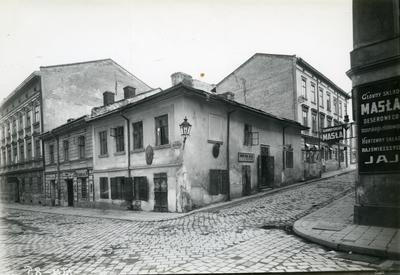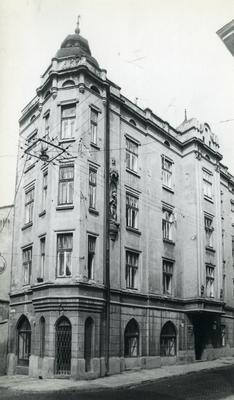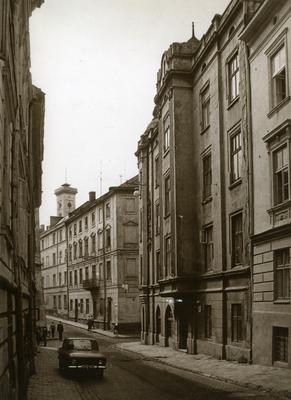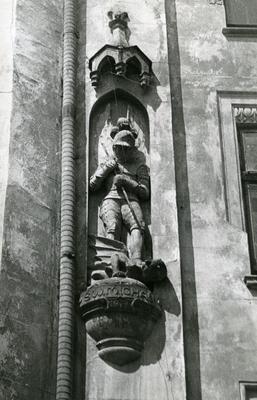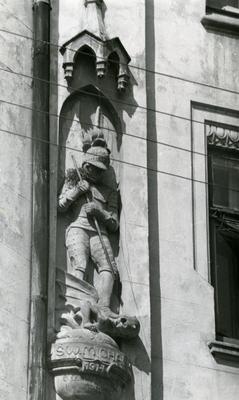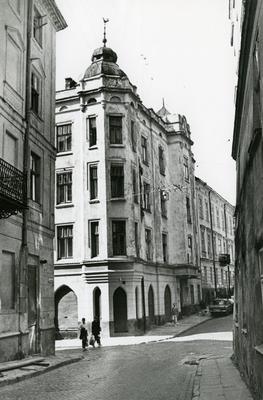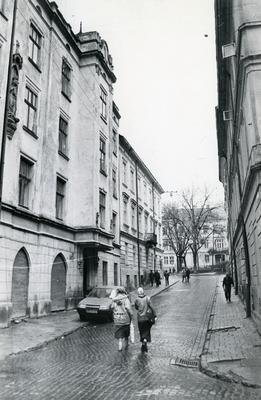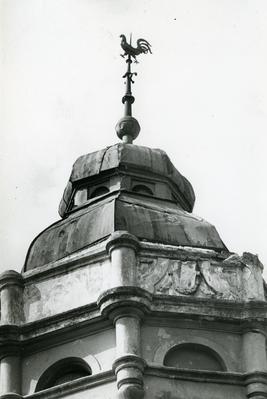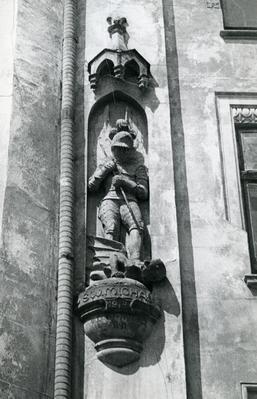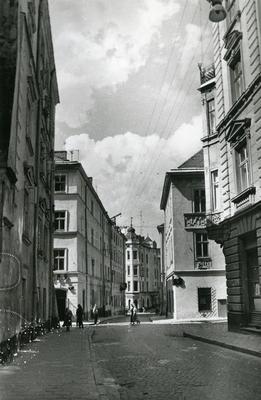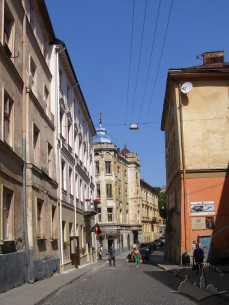Vul. Drukarska, 11 – residential building ID: 2049
The residential house on Drukarska (“Printer”) street, 11, was built by the constructor Michał Makowicz in 1912. It was erected on the demolished town defensive fortifications and is an example of late Secession-style townhouse in Lviv. According to the resolution of the Lviv regional executive committee number 393 dated 22 November 1988, the house was entered into the local register of monuments under protection number M-908.
Story
Early 19th c. – a stone house is built in place of an old wooden one.
1912 – a four-story residential house is built in place of the previous one.
The house was built in 1912 in place of an old one which was erected in the early nineteenth century. The old little one-story house was situated at the corner of the then Nyzhnia Virmenska (“Lower Armenian”, now Lesi Ukrainky) and Drukarska streets. In 1864 the latter did not have a name; it was called “the street that leads to the wood market”. The wood market was at that time in present-day Danyla Halytskoho square. This old house was built instead of a wooden house which had been situated between the low and the high town walls before these walls were demolished at the turn of the nineteenth century.
The present-day four-story house was built and owned by the constructor Michał Makowicz, a Ukrainian. Michał Makowicz was the author of the first project of Taras Shevchenko monument in Lviv (1898). In 1912, he was also on the jury of the contest for the construction of the Craftsmen Unions Society’s building (now Lviv regional puppet theater). The house built by Makowicz differs from the other buildings on Drukarska street by its shape and scale. Its style was influenced by late Secession which was the leading style of Europe’s architecture at that time.
In 1913, the house was inhabited by small traders and Jewish profiteers. Among the other residents the actress Stefania Wołoszyn, the restaurant keeper Adolf Stern, the merchant Sałomon Bardach can be mentioned.
Architecture
The house is situated on the narrow parcel of the northern quarter that borders on the northern line of the town fortifications and is limited by Lesi Ukrainky, Drukarska and Krakivska streets as well as Danyla Halytskoho square. As regards the house architectonics, a certain disagreement can be seen in the selection of architectural forms and details. The ground floor is accentuated by a cornice; the window and door openings on this floor are Gothic in form. Gothisizing elements are used for the upper floors windows trimming. The house is crowned with a low attic; the corner is accentuated with a dome which serves as a compositional element of the streets intersection. There is a three-story-high bay over the entrance door; it is finished with a semicircular pediment on the attic. To the left, in a niche on the third floor of the façade facing Drukarska street there is a statue of St. Michael as this was the patron of the house owner, Michał Makowicz. Over the statue, there is a canopy which looks Gothic in form; on the pedestal below, one can also see the date (1914) and an inscription that reads: “M. Makowicz B. M.”.
The house present condition corresponds to the project except a number of minor changes aimed at simplification of some architectural details, e.g. the shape of the door, dome, attic. The house has undergone no repairs or adaptation. The ground floor premises were earmarked for shops.
The building has preserved the character of an Art Nouveau stone house of the early twentieth century.
People
Adolf Stern – a restaurant keeper.Mychailo Makovych (also known as Michał Makowicz) – a constructor, the owner of the residential house built according to his own design. Makowicz was the author of the first project of Taras Shevchenko monument in Lviv (1898). He was also on the jury of the 1912 contest for the construction of the Craftsmen Unions Society’s building (now Lviv regional puppet theater).
Salomon Bardach – a merchant.
Stefania Wołoszyn – an actress.
Sources
- State Archive of Lviv Oblast (DALO) 2/3/11.
- DALO 2/1/3275. URL: https://e.archivelviv.gov.ua/file-viewer/230053#file-1302375
- Księga adresowa król. stoł. miasta Lwowa (Lwów, 1913).
- Jakub Lewicki, Między tradycją a nowoczesnością. Architektura Lwowa lat 1893–1918 (Warszawa, 2005).
- Архітектура Львова. Час і стилі XIII–XXI ст. (Львів: Центр Європи, 2008), 720 с.
- Борис Мельник, Довідник перейменувань вулиць і площ Львова (Львів: Видавництво Світ, 2001).
- Володимир Вуйцик, Leopolitana II (Львів: Класика, 2012).
Citation
Oksana Boyko, Vasyl Slobodyan, "Vul. Drukarska, 11 – residential building", Lviv Interactive, (Center for Urban History, 2012). URL: https://lia.lvivcenter.org/en/objects/drukarska-11/
Urban Media Archive Materials
